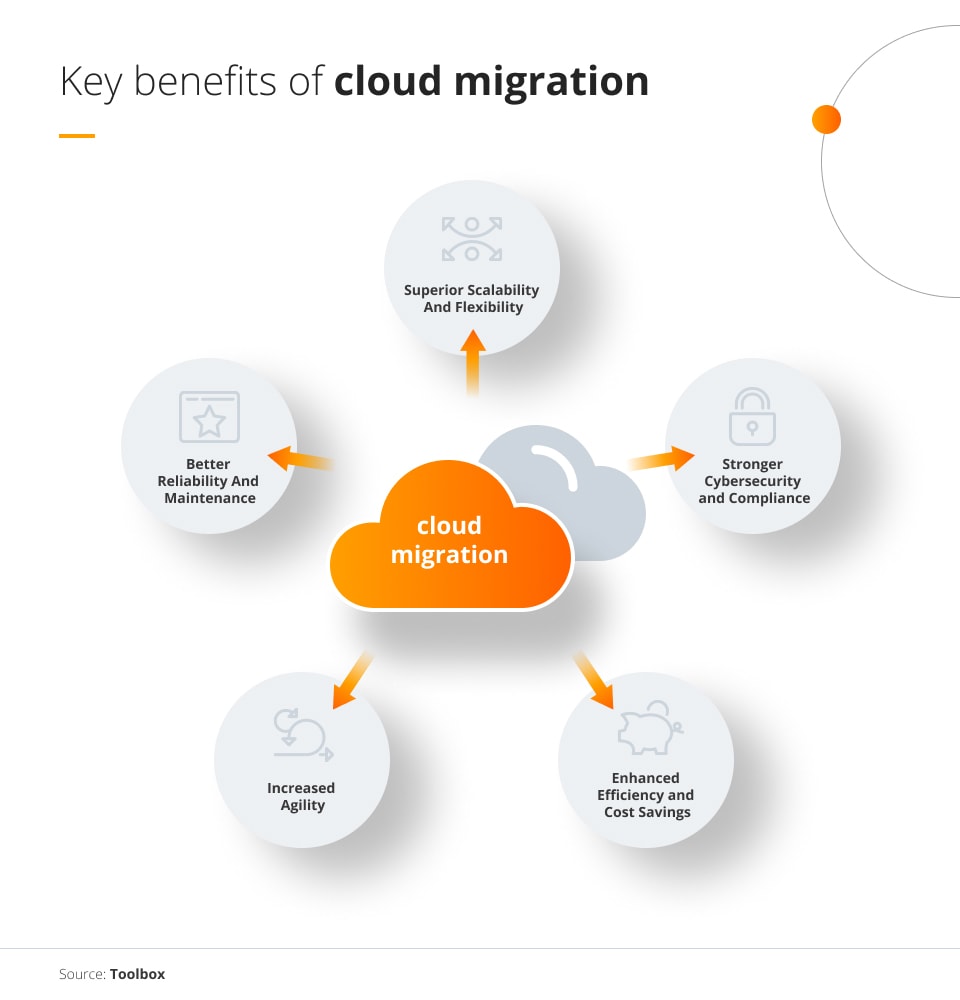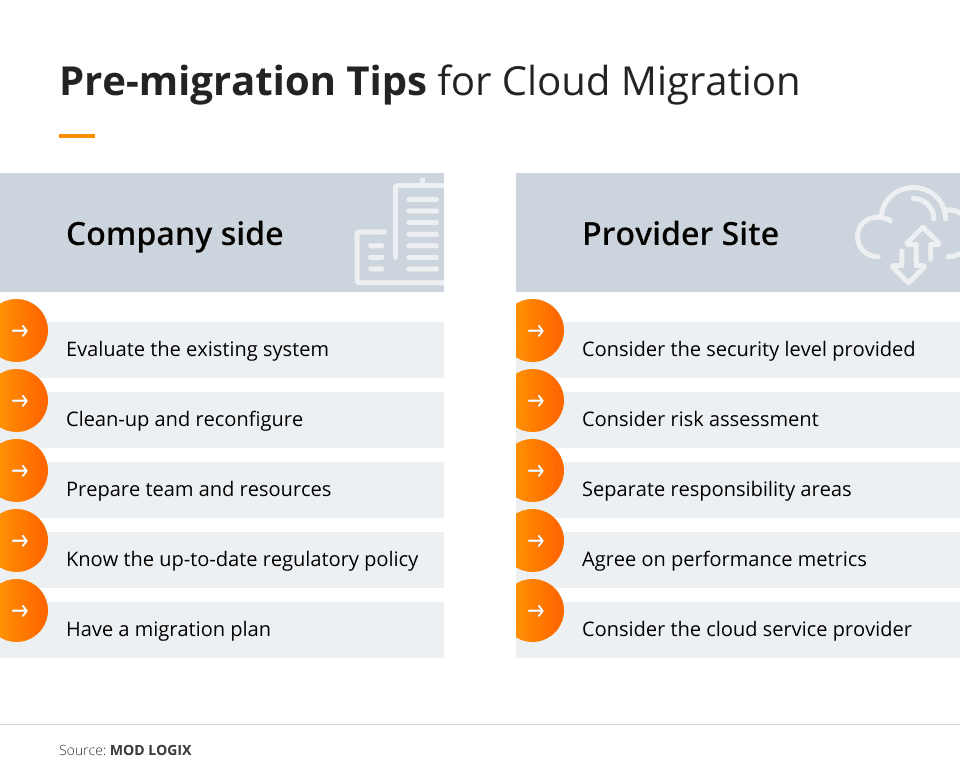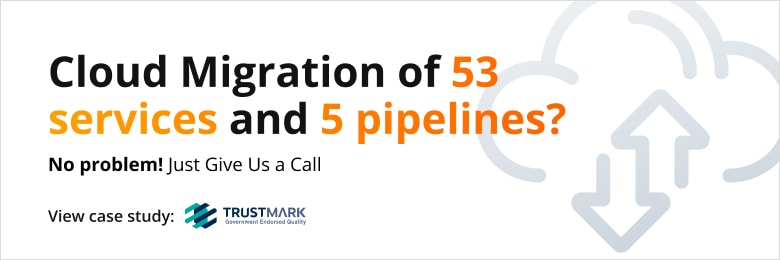
Company cloud migration examples: companies that migrated to the Cloud
Cloud migration is now in full swing. Before the pandemic it was a popular way to go, but today cloud migration became a must-have for every organisation, no matter how big or small. What is cloud migration, why companies decide to migrate to the cloud and what does it take to ensure successful delivery of a cloud migration strategy? Let's find out!
What is cloud migration?
To start with, let’s check what cloud migration is.
The COVID-19 pandemic, the war in Ukraine and the impending recession accelerated the process of cloud migration for many companies, mainly due to the global shift to the online world and cloud businesses. People working remotely needed instant access to their employers’ assets, and cloud migration granted it, made it safe, and obvious.
Why are companies moving to the cloud?
Today, cloud migration is seen as an indispensable element of every digital transformation. Companies decide to turn to cloud businesses as it has massive impact on their operations, customer service and efficiency.
The most important benefits of cloud migration include:
cost effectiveness – cloud migration allows to cut down (or even eliminate) costs of maintenance of an on-premises data centre,
reliability – cloud service providers guarantee reliability of their cloud solutions, eliminating any risks related to a workstation failure,
mobility – data saved in cloud means increased mobility and allows access from various devices, including smartphones and tablets,
sustainability – statistics say using cloud solutions reduces energy consumption and carbon emissions by at least 30% compared to the use of on-site servers,
improved productivity – cloud migration decreases the amount of in-house work related to the maintenance of infrastructure, allowing IT teams to focus on other important work,
improved security – information stored in cloud is encrypted which protects it from cybercriminals and any unauthorised access,
improved scalability and flexibility – cloud migration allows companies to optimise and adjust their resources to their current needs and situation.

Related reading:
- Cloud computing guide: the comprehensive ebook
- The cost of cloud migration: things to know before the Big Data transfer
- CloudOps – solutions for cloud-based businesses
Examples of companies that have migrated to the cloud
A recent research states that in the next year as many as 48% of companies plan to migrate at least half of their applications to the cloud, while 20% want to do the full cloud migration.
Which of the big players have already implemented their cloud migration strategy?
Some of the companies that have already moved to the cloud include:
Netflix
Netflix is widely recognised as a pioneer in cloud migration and has one of the most well-known case studies in this field. The company’s journey to the cloud started around 2008, and it was a significant undertaking that transformed the way they deliver their streaming services.
In 2009, Netflix formed a strategic partnership with Amazon Web Services (AWS). They chose AWS as their primary cloud provider due to its global reach, extensive infrastructure, and advanced cloud services. By leveraging AWS, Netflix aimed to enhance scalability, improve performance, and reduce time-to-market for new features.
The key benefits of Netflix’s cloud migration were:
global reach – leveraging AWS’s global network of data centres, Netflix could serve its content to customers all around the world with reduced latency,
scalability – the cloud allowed Netflix to dynamically scale their infrastructure to handle fluctuating demand, especially during peak usage periods,
cost optimisation – by adopting a cloud-based pay-as-you-go model, Netflix could optimise costs based on actual usage, avoiding overprovisioning of resources,
faster innovation – cloud infrastructure enabled Netflix’s development teams to deploy new features and updates more rapidly, accelerating their innovation cycle,
improved reliability – AWS’s robust infrastructure and redundancy features contributed to increased service reliability and uptime.
Netflix’s cloud migration case study has served as an inspiration for many other companies looking to harness the benefits of cloud computing. Their successful migration has demonstrated how embracing cloud technologies can transform a business and enable it to scale globally while delivering a high-quality user experience.
Instagram
Instagram has a significant presence on the cloud. Its cloud journey is closely linked to Facebook’s cloud infrastructure, as Facebook acquired Instagram in 2012.
The benefits of Instagram’s cloud migration strategi include:
integration with Facebook’s cloud – after the acquisition, Instagram began its journey of moving its infrastructure to Facebook’s cloud, which is based on its data centres and cloud infrastructure, particularly on Facebook’s own data centres and AWS. Facebook has a massive global infrastructure that powers its own services, including the social media platform and Instagram.
leveraging Facebook’s cloud expertise – Facebook’s extensive experience in cloud computing and managing large-scale applications has played a crucial role in the successful cloud migration of Instagram. By integrating with Facebook’s cloud, Instagram was able to take advantage of the massive infrastructure and scalability it offered.
scaling and performance – cloud migration allowed Instagram to scale its infrastructure dynamically, handling the ever-increasing user base and the constant growth in photo and video uploads. This scalability ensured a smooth user experience even during peak traffic times.
infrastructure flexibility – moving to the cloud provided Instagram with the flexibility to deploy and manage their services more efficiently. With cloud resources, they could allocate computing power and storage based on demand, optimising costs while maintaining performance.
data and content delivery – cloud infrastructure enabled Instagram to implement efficient content delivery networks (CDNs) to serve images and videos to users around the world. This helped reduce loading times and improve the overall user experience.
continuous evolution – as with any cloud migration, the process of optimising and fine-tuning the cloud infrastructure is ongoing. Instagram continues to refine its cloud architecture and embrace new cloud technologies to enhance its services.
Apple
Apple has been gradually embracing cloud technologies, offering services like iCloud for data storage, synchronisation across Apple devices and their famous Siri application. However, unlike some other companies, Apple has not entirely migrated all its services to third-party cloud providers and often relies on its own data centres.
Some of the benefits of Apple’s cloud journey and key aspects of their cloud services include:
iCloud – one of the most prominent aspects of Apple’s cloud migration is iCloud, which was launched in 2011. iCloud is a cloud-based service that allows users to store data such as photos, videos, documents, and device backups securely in the cloud. This service enables seamless synchronization of content across Apple devices, including iPhones, iPads, Macs, and even Windows PCs.
data synchronisation – Apple’s cloud infrastructure facilitates the synchronisation of various user data, settings, and content between devices. For instance, if you take a photo on your iPhone, it can be automatically synchronised and made available on your iPad, Mac, or other connected devices through iCloud.
app data and keychain – iCloud also stores app-specific data, preferences, and settings for various Apple apps, allowing users to access their data consistently across devices. Additionally, iCloud Keychain securely stores passwords, payment information, and other sensitive data, making it accessible and synchronised across all Apple devices.
continuity and handoff – Apple’s cloud services allow users to seamlessly switch between their iOS and macOS devices while performing tasks like phone calls, messaging, browsing, and more.
CloudKit – Apple’s CloudKit is a development framework that enables app developers to leverage Apple’s cloud infrastructure to store app data, facilitate user authentication, and enable features like push notifications and sharing data between users.
Apple Music and Apple TV+ – Apple Music and Apple TV+ are cloud-based streaming services that allow users to access a vast library of music and video content from the cloud, providing a seamless entertainment experience across devices.
Etsy
Etsy is an e-commerce platform focused on handmade and vintage items, and its migration to the cloud aimed to improve scalability, performance, and cost-effectiveness. Before migrating to the cloud, the company primarily relied on traditional on-premises data centres to host its platform. As the company experienced rapid growth and an increase in user traffic, managing and scaling their infrastructure became challenging and costly.
In 2011, Etsy began exploring the idea of moving to the cloud to address its scaling and operational challenges. The company evaluated various cloud providers and ultimately chose to migrate to Google Cloud Platform (GCP) due to its features, scalability, and global presence.
The key benefits of their move included:
leveraging Google Cloud Platform (GCP) – Etsy utilised various services offered by GCP to modernise its infrastructure and architecture. Some of the key services leveraged include Google Cloud Storage for data storage, Google Kubernetes Engine (GKE) for container orchestration, and Google BigQuery for data analytics.
microservices architecture – during the migration, Etsy adopted a microservices-based architecture, breaking down its monolithic application into smaller, more manageable services. This approach enabled faster development and deployment of features.
scalability and performance – by moving to the cloud, Etsy could scale its infrastructure dynamically based on demand. This capability allowed them to handle traffic spikes during peak times and events like Black Friday and Cyber Monday.
cost efficiency – cloud computing provided Etsy with a pay-as-you-go model, allowing them to optimise costs by paying only for the resources they actually used. This approach eliminated the need for overprovisioning and reduced capital expenditure on hardware.
global reach – Etsy’s cloud migration enabled the platform to expand its services and reach users around the world efficiently. GCP’s global network of data centres allowed them to serve content to customers with reduced latency.
focus on innovation – by offloading the management of infrastructure to GCP, Etsy’s engineering teams could focus more on innovating new features and enhancing the platform’s user experience.
The successful cloud migration allowed Etsy to handle its growth more effectively, improve site performance, and offer a better experience to its users and sellers.
Capital One
Capital One is a financial services company that has undergone a significant cloud migration journey. Capital One’s cloud migration began in the early 2010s and has been a transformational process for the company’s IT infrastructure and services.
Before migrating to the cloud, Capital One, like many other large enterprises, operated a traditional IT infrastructure with on-premises data centres. This setup required significant capital investment in hardware, and scaling to meet increased demand was often time-consuming and challenging.
Capital One recognised the potential benefits, such as cloud scalability and elasticity, agility, cost efficiency, and the ability to innovate at a faster pace. The company made a strategic decision to adopt cloud technologies and become more cloud-native.
The benefits of their cloud migration include:
scalability and flexibility – by migrating to the cloud, Capital One gained the ability to scale its infrastructure up or down rapidly based on demand, optimising resource utilisation and improving cost-effectiveness,
security and compliance – as a financial services company, data security and compliance were of paramount importance to Capital One. The company worked closely with cloud providers to ensure that all data and applications complied with relevant regulations and industry standards,
embracing cloud-native technologies – Capital One embraced cloud-native technologies such as containers and microservices architecture, enabling faster development cycles and better service reliability,
leveraging Big Data and analytics – the cloud migration also facilitated Capital One’s ability to leverage big data and analytics for business insights and decision-making, helping the company improve its services and customer experience,
innovation and DevOps – cloud adoption allowed Capital One’s development teams to adopt DevOps solutions, accelerating the deployment of new features and updates while maintaining high-quality service delivery.
Capital One’s cloud migration has been a success story in the financial services industry, demonstrating the transformative power of cloud technologies for large enterprises in delivering their financial services to customers.
Spotify
Spotify has a notable cloud migration journey that began around 2016. Spotify is a popular music streaming service with millions of active users worldwide. Their migration to the cloud aimed to address scalability challenges, improve service performance, and enable faster development cycles. Spotify’s cloud migration was a multi-year effort that involved careful planning and execution. The company adopted a gradual approach to minimise disruption to their services and ensure a smooth transition.
Spotify’s cloud migration brought several advantages:
scalability – the cloud’s elastic nature allowed Spotify to scale their infrastructure seamlessly based on user demand, ensuring a smooth streaming experience for millions of users,
cost optimisation – with a pay-as-you-go cloud model, Spotify optimised costs by paying for resources based on actual usage, rather than maintaining overprovisioned on-premises hardware,
faster innovation – the cloud’s flexibility and automation capabilities enabled faster development cycles, allowing Spotify to release new features and updates more frequently,
global reach – Spotify’s cloud infrastructure allowed them to serve users across the globe efficiently, reducing content delivery latency,
focus on core competencies – by offloading infrastructure management to GCP, Spotify’s engineering teams could focus on improving the platform and user experience.
Spotify’s cloud migration case study has been a significant success story, showcasing the benefits that cloud computing can bring to large-scale services. It illustrates how embracing cloud technologies can transform a business, enabling it to handle growth, enhance performance, and innovate more effectively.
Dropbox
Dropbox’s cloud migration was a significant undertaking as they transitioned from traditional data center infrastructure to a cloud-based model. Prior to the migration, Dropbox primarily relied on its own data centres to store and manage user data. As the demand for their services grew rapidly, they realised the need for a more scalable and flexible infrastructure to accommodate their expanding user base.
To achieve this, Dropbox decided to move to public cloud providers. However, instead of choosing a single cloud provider, they took a multi-cloud approach to enhance redundancy and reduce potential service disruptions.
The company announced its migration to the cloud in 2016 and stated that they would use a combination of cloud providers, including Amazon Web Services (AWS) and their own data centers. Dropbox’s migration to the cloud was a gradual process and took several years to complete.
The key benefits of Dropbox’s cloud migration were:
scalability – with cloud providers like AWS, Dropbox could scale their infrastructure dynamically based on user demands, ensuring seamless user experience during peak usage times,
cost efficiency – cloud providers offer a pay-as-you-go model, allowing Dropbox to optimise costs by paying only for the resources they used,
redundancy and high availability – utilising multiple cloud providers allowed Dropbox to enhance redundancy and maintain high availability, reducing the risk of downtime,
geographic reach – Dropbox’s cloud migration allowed them to expand their services to users across the globe more efficiently by leveraging cloud providers’ global data center infrastructure,
focus on core business – by offloading infrastructure management to cloud providers, Dropbox’s engineering teams could focus more on building and improving their core services.
Dropbox’s cloud migration is considered a successful case study of how a company can leverage cloud technologies to address scalability and operational challenges while providing a better user experience.
How many companies are migrating to the cloud?
You may wonder: what percentage of companies use cloud?
The rate of cloud migration has been increasing steadily over the years, with more and more companies realising the advantages of moving their IT infrastructure and services to the cloud. Many startups are “born in the cloud,” meaning they start their operations directly on cloud platforms without investing in on-premises infrastructure. At the same time, established enterprises are transitioning from traditional data centers to cloud-based solutions.
Statistics say that as many as 94% of enterprises use some kind of cloud services. As of 2022, the global cloud computing industry market was worth $480.04 billion. According to a research by Gartner, by 2025 95% of data will be hosted in the cloud and over 95% of businesses will be using cloud computing.
Given the trend, global cloud migration services market is also on the rise, as shown on the diagram below.

Tips for maintaining successful long-term cloud computing implementation plans
While cloud migration is a necessity and it can greatly improve your efficiency while lowering your IT costs, it is important to implement it wisely, as the cloud migration can also create problems if it’s not designed and managed in the right way.
Here are some tips for maintaining successful long-term cloud migration strategy:
1. Analyse your situation and set a goal for your cloud migration
Successful cloud migration process starts with a thorough analysis of your current system, needs and problems you want to address. That’s done, think of the goal you want to achieve and the deadline for your cloud migration project. Then prepare your cloud migration plan.
Related reading:
- Deployment models and considerations of cloud migration
- Cloud vs. On Premise Software: Differences, Benefits and Risks
- Top benefits of cloud-based software development your business needs right now
- Enterprise cloud computing: strategy and benefits
2. Check and test various solutions
Knowing your goal and needs, check which solutions and cloud providers would be best for your cloud strategy. See what others think of them, execute a proof of concept and experiment, also considering the security level different solutions provide.
Related reading:
- Which cloud architecture model is best for security?
- Public Cloud vs Private Cloud vs Hybrid Cloud: What are the differences?
3. Choose a respectable cloud migration partner
When choosing your future cloud migration partner that will take you through your cloud journey, take into consideration:
the company’s reputation,
reviews they got from their other clients,
their experience in implementing cloud migration.

Related reading:
4. Decide on the right method of cloud migration deployment
When implementing your cloud migration strategy, it is important to choose the right method of your migration deployment, depending on the work packages you have.
Related reading:
5. Monitor and optimise
Monitoring and optimising your system are one of the most crucial things you need to keep doing after your cloud migration process finishes. You can do it in-house, or you can choose an external partner that will take care of it, making sure your solution is always updated and works to its full potential.
Related reading:
- The most common problems in cloud implementation
- What you need to consider when choosing cloud computing consulting?
6. Train your staff how to use cloud computing
When undertaking your digital transformation and doing cloud migration process, never forget about informing and educating your team on what’s exactly going on and what’s their part in the whole process.
Related reading:
- What is Cloud Infrastructure Entitlements Management?
- Cloud operations – how to effectively manage and maintain cloud solutions?
Who should (or shouldn’t) migrate to cloud platform?
Deciding whether to migrate to a cloud platform depends on various factors, and it’s essential to carefully evaluate the needs and goals of your organisation. While cloud computing offers numerous benefits, it may not be the best fit for every business.
Who should consider cloud migration:
Scalability and Flexibility Needs
If your organisation experiences fluctuating demands for IT resources or plans to scale rapidly, cloud platforms offer the flexibility to scale up or down based on demand. This can be particularly beneficial for businesses with seasonal or unpredictable workloads.
Cost Efficiency
Cloud services often follow a pay-as-you-go model, allowing businesses to avoid large upfront investments in hardware and infrastructure. Organisations can optimise costs by paying for resources they consume, making it appealing for those seeking cost efficiency.
Rapid Innovation
Cloud platforms enable faster deployment of applications and services, allowing businesses to innovate and bring new features to market more quickly. This is advantageous for companies in competitive industries where time-to-market is critical.
Disaster Recovery and Business Continuity
Cloud providers offer robust data redundancy and disaster recovery features, reducing the risk of data loss and downtime. For organisations concerned about data protection and business continuity, cloud migration can enhance their resilience.
Global Reach
Cloud providers have data centers located around the world, allowing businesses to serve their customers in various geographic regions efficiently, reducing latency and improving user experience.
Collaborative and Remote Work
Cloud computing services facilitate remote collaboration, enabling teams to access and work on projects from anywhere with an internet connection. This is especially relevant in the context of remote and distributed work environments.
Who might not be ideal candidates for cloud migration:
Sensitive Data and Compliance Concerns
Some organisations, such as those in highly regulated industries (e.g., finance, healthcare), may have strict data compliance requirements that are better addressed with on-premises solutions or private cloud deployments.
Legacy Systems and Complex Applications
Migrating complex legacy systems with deeply integrated on-premises infrastructure might present challenges. In such cases, a hybrid cloud approach or gradual migration might be more appropriate.
Cost and Resource Constraints
For some smaller businesses with minimal IT requirements, maintaining on-premises infrastructure could be more cost-effective than transitioning to the cloud.
Unique Technical Requirements
Certain businesses may have unique technical requirements that are better met with specialised on-premises solutions or dedicated hosting.
Data Sovereignty
Organisations with strict data sovereignty regulations might face challenges with storing sensitive data on cloud platforms, especially if data residency requirements dictate local data storage.
It is crucial for organisations to conduct a thorough analysis of their specific needs, existing infrastructure, budget, security requirements, and growth plans before making a decision regarding cloud migration. Some organisations may find a hybrid cloud model, which combines on-premises and cloud solutions, to be the most suitable approach to meet their diverse needs.
Seeking advice from cloud experts and conducting a comprehensive cost-benefit analysis can help in making an informed decision.
When choosing your cloud adoption partner…
When planning your migration to the cloud and thinking about various cloud migration strategies, the most important thing is to ask questions and have a reliable source to answer them.
We will be happy to help and discuss your cloud migration risks, common migration challenges and what cloud solutions will be best for your business.





